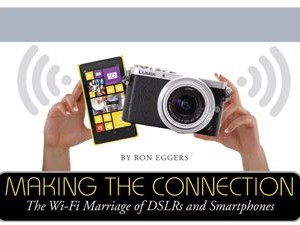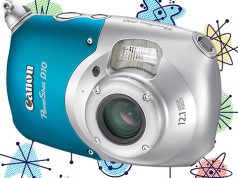
Cameras with Wi-Fi capabilities have been around for a number of years. Until relatively recently, the primary Wi-Fi function was to facilitate the uploading of images to specific websites or to assist in wireless printing. Today, Wi-Fi is increasingly being used as part of a photographer’s workflow, both to remotely control digital cameras and to remotely view captured images—enhancing the photography experience.
The latest generation of smartphone apps has eliminated the cable that had been part of operating a digital camera remotely and transferring images to a computer. Because of the equipment and cost involved, remote control photography was primarily a professional option.
Utilizing smartphone links through Wi-Fi is opening up the process to the general public. With the right camera, iOS, Android or Windows smartphone, and the appropriate app, remote wireless photography is becoming an affordable option for any photographer.
With smartphone controls, users can do a lot more than simply place a camera in a location and remotely fire the shutter. They can control focusing and set exposure adjustment and see the exact framing the camera sees, instantly, without having to touch the camera. And digital camera/smartphone connections are changing the way photographers can shoot: it’s possible to place a camera in a location where it would be impractical, or dangerous, for a photographer to be, yet still be confident that framing, focus and exposure are correct.
The ease of remote, virtual control is also opening up photography to a segment of the population that couldn’t easily be involved before. It’s opening up serious photography to people with functional disabilities that limit their capabilities of working with cameras. In these situations, it’s easier to work with a smartphone to make camera adjustments than to make them on the camera itself.
Of course, it’s also easy to transfer images from the camera to the phone wirelessly. One major advantage of this is the ability to back up images almost instantly, even if something were to happen to the camera. If, for example, the camera is in a hazardous area and it is destroyed during the shoot, any images captured are still safe.
Another application that’s becoming increasingly popular is the drone-cam. Photographers are suspending digital cameras under radio-controlled, miniature multi-rotor drones and using them to shoot both stills and video. While the distance that the drone will send digital data is limited to the range of the Wi-Fi signal, these drone/camera combos can generate remarkable aerial images and video footage.
Just about any smartphone can be used for Wi-Fi camera control. But some of the newer models can actually compete with the digital cameras they’re intended to work with. Smartphones like the Android-based, 16 megapixel, 10x zoom Samsung Galaxy S4 Zoom and the Windows-based, 41MP, Zeiss-optics-equipped Nokia Lumia 1020 technically still fall into the cameraphone category, but their capabilities and resolution put their capture abilities in line with more sophisticated digital cameras.
A Collection of Connected Cameras
Most camera manufacturers are bringing out cameras that can be paired with smartphones, everything from point and shoots to compact system cameras. On the high-end side, Canon has a number of models with Wi-Fi, including the EOS 6D DSLR. Priced at $1,899 body only, it features a 20.2MP full-frame CMOS sensor, a continuous capture rate of 4.5 fps and Full HD video recording with manual exposure control. Its ISO range is expandable to 102,400, its Digic 5+ image processor is fast and effective at keeping electronic noise down, and it employs an 11-point AF system with EV -3 sensitivity. Combined, all these factors make it ideal for shooting in low light.
With the 6D’s built-in Wi-Fi and the EOS Remote app installed on a smartphone, it’s possible to fully control the camera and upload images remotely. The app supports full EOS functionality, including the ability to set focusing points and get feedback when those areas in the frame are in focus. When all the adjustments have been made and the shutter has been triggered, captured images can be reviewed, saved, transferred and shared, individually or in groups.
Until recently, Nikon’s approach to DSLR Wi-Fi was to do it through an optional module—a wireless mobile adapter. But the company released its first DSLR with integrated Wi-Fi, the D5300. Besides Wi-Fi, it features GPS for geotagging. It’s designed around a 24.2MP DX-format CMOS sensor and has an ISO range that expands to 25,600, a 39-point AF system with 9 cross-type sensors, a capture rate of 5 fps and is capable of recording 1080p Full HD video with stereo sound. At $799.95 body only, when the D5300 is paired with Nikon’s Wireless Mobile Utility on a smartphone, it’s simple to control the camera remotely, transfer images to the smartphone and upload them to the web.
One of the considerations of rolling off images from the camera to the smartphone as they’re being taken is throughput. While it might be interesting to occasionally transfer a 24.2MP image from a camera to a smartphone, just to see how it looks, unless there is a specific situation where you can’t access the camera directly or there’s the potential for the camera being damaged during the shoot, you wouldn’t want to clog up your phone or waste time transferring high-res images. But with the Nikon app, it’s possible to choose the size at which images are going to be downloaded, letting users keep high-res images on the memory card while transferring low-res versions for quick viewing and the web.
Besides DSLRs, there are a growing number of broader range cameras that can link with smartphones, including some of the new lightweight, mirrorless compact system cameras with interchangeable lenses. The Olympus PEN E-P5 is a good example. Reminiscent of the old rangefinder PEN film cameras, the easy-to-handle Micro Four Thirds-format E-P5 is a sophisticated piece of camera gear. Its Live MOS sensor captures images at a 16.1MP resolution, and it has a maximum ISO of 25,600 and comes packaged with a fast M.Zuiko 17mm f/1.8 lens. With its frequency acceleration sensor technology autofocus system, built-in 5-axis image stabilization, 9-fps capture and a high shutter speed of 1/8,000 second, the E-P5 is designed for serious shooting.
To facilitate remote operations, Olympus developed the OI.Share app. Once the app has been downloaded and installed on a phone, it’s possible to sync the E-P5 by taking a shot of the QR code on the camera’s LCD. With OI.Share, the smartphone can make camera setting adjustments, set focusing points, fire the camera and retrieve images.
Sony has taken a somewhat different approach with its QX Cyber-shot cameras. Rather than using a smartphone as an external control and viewing device for the digital camera, Sony’s lens-shaped QX100 and QX10—which can operate as stand-alone cameras—attach and sync with a smartphone, so that the phone captures images and video via the camera’s pro-grade lens and sensor combo, as well as Bionz processor. The DSC-QX100 has a 20.2MP Exmor R CMOS sensor and 3.6x Carl Zeiss Vario-Sonnar T* lens ($500); the DSC-QX10 uses an 18.2MP Exmor R CMOS sensor and 10x optical zoom Sony G lens ($250).
Sony’s QX series falls into a new category being called “lens-style” cameras, with captured images saved both on the camera and the phone for instant sharing and editing with mobile apps. No cables are required between the two elements, since all communications are handled through Wi-Fi.
Attaching a QX camera to a smartphone is simple. An adjustable mount attaches to the phone, and the camera is attached to it. Utilizing Sony’s PlayMemories Mobile app, the QX camera is fully functional, with all controls handled through the smartphone. The camera doesn’t have to be attached though, so it can also be used remotely or mounted on a tripod.
All of the iPhone, Android and Windows apps released by the different manufacturers can be quickly downloaded. It’s pretty easy, but Sony simplifies the app loading process. If the smartphone being used with the QX100 is Near Field Communication (NFC) enabled, it’s possible to download the app directly from the camera by simply tapping the devices together.
NFC technology also makes it possible to send captured images and video between adjoining NFC-enabled smartphones almost instantly. Samsung has taken the lead in bringing out NFC-enabled Android devices. So, it’s no surprise they also released the first truly connected digital camera with the 3G/4G LTE Android OS platform integrated. The Samsung Galaxy Camera features a 21x optical zoom, 23mm wide-angle lens, a 16.3MP BSI CMOS sensor, a 4.8-inch HD LCD and Android 4.1 Jelly Bean to capture and share photos and Full HD Video. The Wi-Fi version retails for $450; the AT&T and Verizon models are priced according to the carrier contract.
Samsung’s Galaxy NX ($1,600) is a high-performance compact system camera with the Android Platform and Wi-Fi connectivity. It features a 20.3MP APS-C-format CMOS sensor, a fast hybrid autofocus system and interchangeable lenses. Users can upload images and post to Facebook, Twitter, YouTube, Instagram and other social media. Plus they can download Android apps to edit captured images.
Whatever technology camera makers are using to make sharing easier for consumers, it’s clear they are making every effort to answer consumer demand for instant photo sharing of quality photos and to enhance their overall photographic experience. Stay tuned for new developments!





